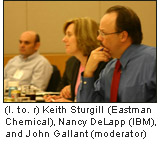
|
|
|
 |
|
 |
Web 2.0 and the Corporation
Roundtable on Digital Strategies June 19, 2007 - Palisades, NY hosted by IBM CIOs and other senior execs from 3M, BT Group, JPMorgan Chase, Cisco, DISA, Eastman Chemical, IBM, ING, Ogilvy, and Time Warner Cable were joined by academics from Tuck for this roundtable. |
||
 Video: Eric Johnson on Web 2.0 and related emerging technologies.
Press Release
Agenda
List of Participants
Discussion Guide
Overview Article
|
|||||
In this roundtable, we explored the potential internal and external use of Web 2.0 to enable global collaboration, the impact on marketing and customer/ultimate consumer engagement, the changing environment for corporate communications and human resources, and the challenges of governance of this phenomenon for corporations. The participants' experiences and views yielded the following insights (see the Overview Article for a complete summary):
- The Web 2.0 phenomenon is characterized by immediacy, simplicity, transparency, non-hierarchical collaboration, virtual communities, and work/personal convergence.
- Web 2.0 represents a powerful new way to engage and build strong relationships with customers, and to improve collaboration internally and with business partners. Corporations will also be challenged to adopt Web 2.0 in order to retain and motivate top talent.
- Web 2.0 puts consumers even more firmly in the driver's seat and renders traditional communications, messaging, and marketing channels less effective.
- Web 2.0's inherent openness also carries risks: competitive, legal, and reputational. Corporations must decide how much to try to control, "channel," or systematize the use of Web 2.0 tools, at the risk of limiting their effectiveness, authenticity or ability to drive innovation.
- IT should be an enabler rather than a gatekeeper for Web 2.0, and all executives, especially in B2B companies, must help show how Web 2.0-enhanced customer loyalty or improved collaboration translates into tangible business value.
| Social Shopping - A center research study on new social shopping applications | |
| The CIO as Strategic Business Partner: Leading Change and Driving Results - An Executive Workshop | |
| Managing Consumer Data - A Tech@Tuck event | |